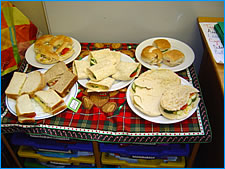 Making DT Work
Making DT Work
Standards in Design and Technology
"Design and technology is about understanding and improving the made world and an important function of the primary school curriculum is to ensure that pupils become better and better at doing just that."
- In the schools visited, standards of achievement in design and technology are generally satisfactory and sometimes good. Standards were judged to be very good in one KS3 setting.
- Most pupils in Key Stages 1 and 2 have a good grasp of the design process. They are able to record ideas in a structured way, their making skills show evidence of refinement and improvement, and pupils appreciate the importance of evaluation as a conclusion to a project.
- A good range of activities are used to support the teaching and learning of design and technology. Pupils in both key stages in the primary phase benefit from experiences in food technology and in working with resistant materials and textiles. An appropriate range of experiences are offered at KS3.
- Good examples were seen of pupils using construction kits to build prototypes of their initial design ideas e.g when making mobile models of vehicles.
- Presentation of work is generally satisfactory, however in the vast majority of primary schools visited there is an over reliance on worksheets and poorly designed frameworks that often stifle the creativity of the more able pupils and preclude the less literate pupils from communicating their ideas in a way that corresponds to their potential.
- Pupils generally have a good knowledge and understanding of the work they have covered. They can describe projects that they have undertaken during the year and are able to relate these experiences specifically to the three aspects of the design process.
- In many of the schools visited pupils have a good grasp of the making skills that contribute to achieving excellence in design and technology. In KS1 pupils begin to show an awareness of the need to measure and cut accurately and these skills are developed appropriately and systematically throughout KS2 and into KS3. In the schools visited pupils show a good awareness of joining and assembling practices and are able to explain decisions made to use a specific joining technique over another, e.g. stitching rather than gluing. Pupils in KS3 show a good awareness of consumer preference and how this can influence the design process.
- All pupils are able to use tools appropriately and safely and make sensible decisions regarding the equipment needed to complete their projects.
- Pupils' ability to refine their design as it develops is underdeveloped. Pupils tend to design and make by adhering closely to their initial ideas. Very little evidence was seen of pupils evaluating their projects as they were progressing and making working notes on their initial plans.
- In general terms pupils are able to apply appropriate finishing techniques when using a range of materials and components.
Standards of Achievement in the Key Skills in Relation to Design and Technology
- The progressive use of ICT to support learning in design and technology is variable, with the standards achieved in some classes not always systematically built upon or exploited effectively. In KS2 some good examples pupils used a spreadsheet to record and interrogate their research findings. In another school pupils make effective use of the internet to research a topic before making their initial designs. In some instances inappropriate or contrived use of computer programs often restrain pupils' creativity, e.g. using a graphic package to draw a picture of a vehicle, using LOGO to draw a poster.
- Good examples were seen of pupils developing their literacy skills, utilising design and technology vocabulary appropriately and accurately. However, at KS3 we witnessed some lack of confidence by pupils in using D&T keywords and subject specific vocabulary.
- In some schools, group work contributes effectively to pupils' learning. They communicate well and discuss ideas, listening to each other's contributions and ideas. Ideas are often given credence and influence the decisions taken. Some very good group work was observed in one KS3 lesson. However in most schools, group work tends to be less dynamic and does not allow all contributions to be valued sufficiently. Pupils are often afforded the opportunity to talk about their designs to their peers as a plenary activity, though opportunities to discuss and question ideas in a systematic way are sometimes lost.
- Evidence suggests that the impact of numeracy as a key skill is developed well at all key stages. Pupils measure accurately using a range of different units, they use graphs and charts to record their research and show an awareness for scale work.
| Continue: Quality of Learning |

